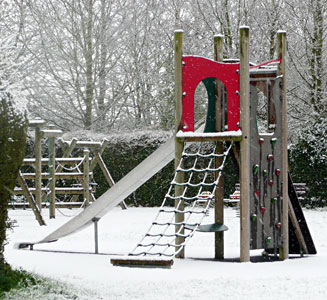Snow Days, Recess and the Application of Some ‘Flinty Chicago Toughness’
Blog Post
Jan. 28, 2009
You can usually count on snow days and school cancellations to precipitate a flurry of opinionated chatter from parents and educators. Today, in
 “We’re going to have to apply some flinty
“We’re going to have to apply some flinty
Funny he should mention recess. Because the topic of recess – more to the point, the lack thereof – was already getting some important press attention even before the snow day digressions. And we think that it deserves some real discussion, especially on cold, snowy days. So pour yourself a cup of hot chocolate and pull up a chair.
This week, a study in Pediatrics showed that recess is associated with better behavior in the classroom. Based on data from thousands of children nationwide, the study examined the relationship between teachers’ ratings of their classroom’s behavior and whether the children in those classrooms had at least a 15-minute break for recess each day. The data showed a significant link between having those breaks and teachers’ positive assessments of their students’ behavior in classrooms. Most troubling, the report showed that children from disadvantaged backgrounds were more likely not to have recess.
The Pediatrics study, led by Romina M. Barros, a pediatrician at the Albert Einstein College of Medicine, adds to the evidence on why children should have breaks from their structured schoolwork and activities. Anthony D. Pellegrini, a professor of educational psychology at the
No matter where, though, the cold is often less a problem for the children than it is for playground aides and teachers who are generally not moving as much as the kids. And in many poorer communities, teachers will tell you, students come to school without coats and gloves. They worry, rightly, that sending children outside without the proper clothing could be harmful.
But given what we know so far about the importance of recess, it seems that these are hurdles that can be overcome on days that are not dangerously cold. Again, considerations of dangerousness will differ by community. But most should agree, especially given the obesity epidemic, that children need time and space for climbing, leaping and running around. We should be doing everything we can to make that happen. Parents should become more informed – schools should help – about how and when to make sure their children dress for outdoor play. Schools that can, perhaps with help from outside non-profits, should stock a deep supply of extra coats and hats. Playground aides, who probably feel the cold more because they have to stand without moving much, could be trained and encouraged to try mini-games with the students that get them moving too.
As I walked my 6-year-old daughter to school this morning, in a neighborhood just outside
(The photograph is of a playground in the U.K.: Compton Street playground in the snow, April 2008)